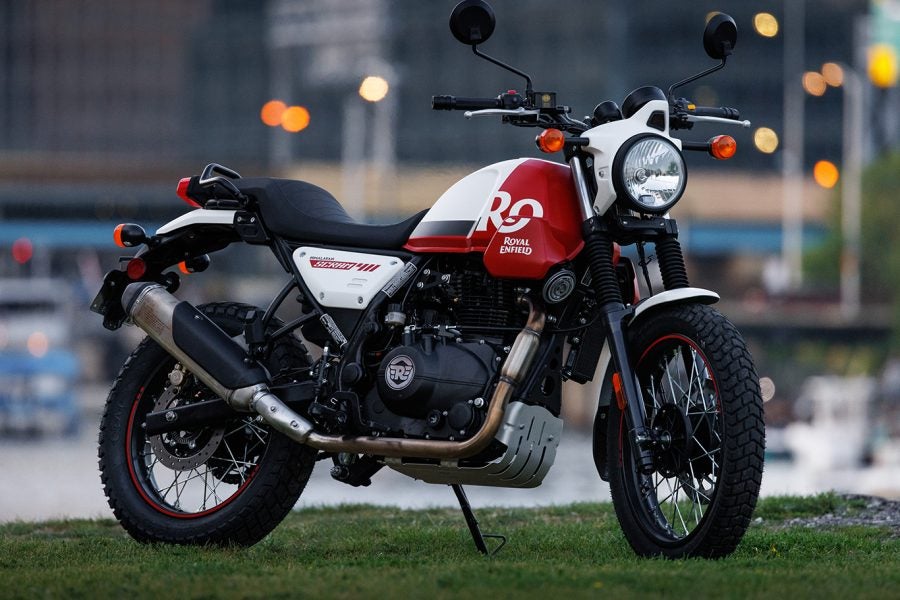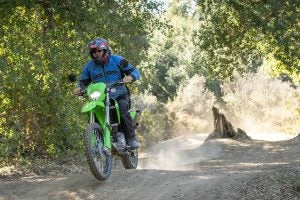Just a few days ago, Royal Enfield confirmed the Scram 411 scrambler would be in North America this fall. Here’s your first ride review, courtesy of David Hilgendorf. Take it away, Dave! – Ed.
Eicher Motors Limited is pursuing worldwide dominance in the middleweight motorcycle segment. The Indian parent company of Royal Enfield sells more than 600,000 motorcycles a year. To put this in perspective, the entire U.S. motorcycle market moved around 550,000 units last year, for all brands combined. Royal Enfield commands a whopping 94 percent market share in 250cc to 750cc motorcycles in India, and the new Scram 411 fits solidly right in the middle.

Photo: RENA-Brandon Bunch
The company witnessed faithful Himalayan owners chopping and bobbing to make the bikes lighter and sleeker. It then identified a gap in market availability of middleweight dual-sport bikes, so it decided to jump into the scrambler game. Maintaining the lightweight, easy to work on, low seat height, and ample ground clearance and suspension travel first introduced on the Himalayan, the Scram trims all pretensions of ADV and fires a bullseye shot at Scrambler styling. TL: DR — We really dig it.
Royal Enfield North America (RENA) is headquartered in Milwaukee, Wisconsin. The location gives the company a better understanding of the American consumer, and is where we started our two-day, 400-mile roundtrip ride to the scenic, hilly and unpopulated Driftless region of Southwest Wisconsin.
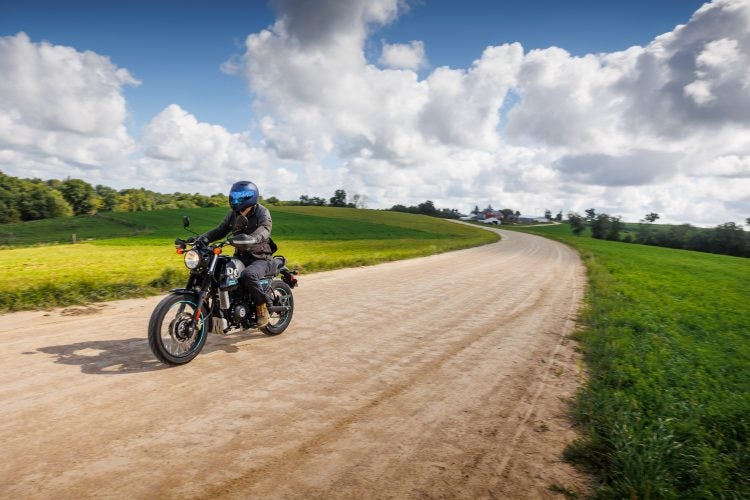
Photo: RENA-Brandon Bunch
The Scram 411 is based on the same Himalayan chassis and LS410, single-cylinder, four-stroke motor, with all the classic angles of British-designed engines. It also has the same flawless fuel injection, which allows it to pass emissions and be imported to America. And it shares the same roughly 21 horsepower and 21 pound-feet of torque at the rear wheel. Though handy when heading off-road, with plenty of low-end grunt at low speeds, the steady, if unspectacular, performance still leaves the top end lacking.
We appreciated the Scram 411’s civilized midrange and its stability up to about 60 mph on paved roadways, though the little single does get quite buzzy at speed. The air-cooled engine presented no overheating issues during our 400 miles of warm-weather riding. However, out of 25 demo bikes on our ride, two experienced oil leaks at the engine gaskets, one of which was enough to lubricate the top of my left boot. Hopefully, RENA spends more time doing pre-dealer-delivery inspections as these come off the boat from India. Stick close to your dealer for the first thousand miles and keep an eye on seals and any parts that might rattle loose. With a three-year unlimited mileage warranty and roadside assistance included, there shouldn’t be much to worry about.

Photo: RENA-Brandon Bunch
The five-speed gearbox reflects its low-speed bias, but overall, it’s a smooth shifter. Second, third and fourth gears are quite tall and versatile within the powerband, so shifting gears is often more of an afterthought. Fifth is only useful when cruising at top speed, which is somewhere around 70 mph, though we maxed out at a displayed 80 mph, going downhill. We did not test for speedo inaccuracies against a GPS, but the Himalayan exhibited such, so don’t be surprised if it’s off a few ticks.
Combining a 430ish-pound wet weight with long-travel suspension makes for plenty of fun, but long stints on the highway really isn’t where this bike shines. The linkage-assisted shock and front forks both provide more than 7 inches of travel, but only the rear is preload adjustable. Handling was good, but not great, which is what we expect from a dual-sport, and we experienced some instability and flex in the chassis at higher speeds. While this makes for a wobbly ride on the freeway, when in an urban environment, or if the going gets dirty, the bike maintains composure. We would have preferred more suspension adjustability, and even an inch less travel, to increase overall stability.
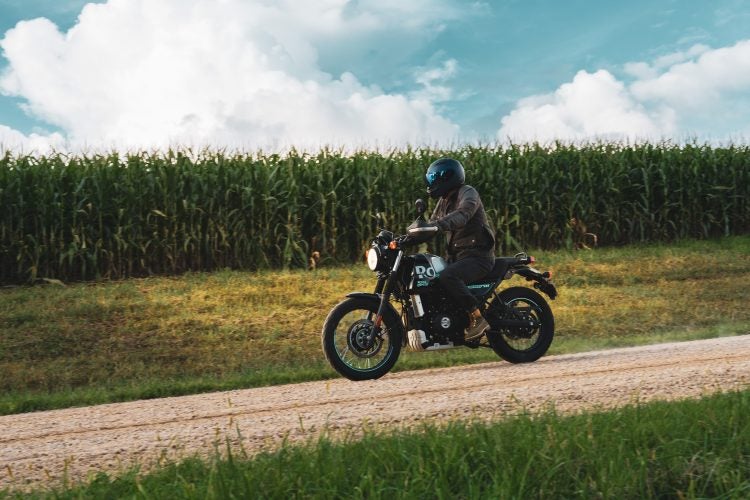
Photo: RENA-Domorak
The robotically welded half-duplex split cradle frame was designed for strength in dual-sport riding. It also helps the bike present a rough-and-ready stance, which can be reassuring when venturing off-road, as compared to competitive scrambler offerings based on street bike platforms. Unsurprisingly, the Scram 411 also remained comfortable when standing on the pegs, with its tall handlebars. The clever cleated pegs with removable rubber inserts are another welcome carryover from the Himalayan.
Designers chose to drop the stance on the Scram 411, arming it with tubed and spoked 19-inch front (versus 21 on the Himalayan) and 17-inch rear wheels, while retaining 8 inches of ground clearance (versus 9). The wheel sizing reduces its offroad prowess slightly when compared to the Himalayan, but increases its roadworthiness and still allows for plenty of maneuverability.
The generic CEAT dual-purpose tires are pavement biased, with limited off-road grip, though traction was not ideal in either case. Unfortunately, the smallish two-piston front calipers don’t provide great braking feel, but steel-braided brake lines and the newly introduced dual-channel ABS might make up for any insufficiencies in the ByBre hardware. Fortunately, there are plenty of tire and brake pad options on the market that could easily and cheaply improve any limitations here.
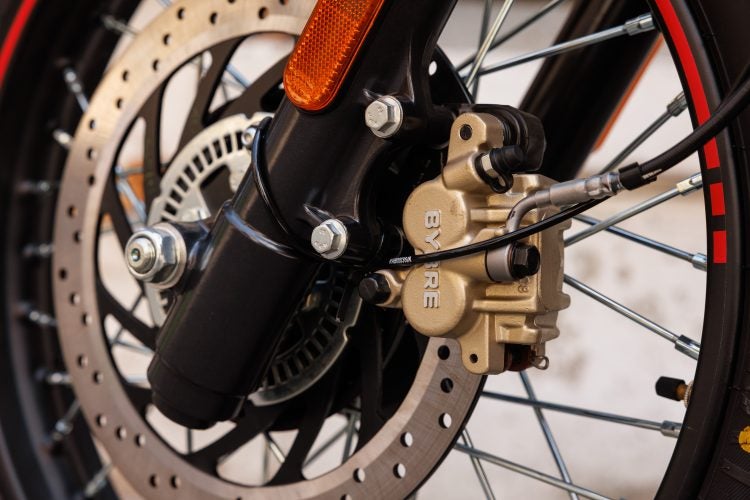
Photo: RENA
We found the Scram 411’s upright riding position geometrically comfortable, though also quite compact. A low 31-inch seat height keeps the ground easily within reach and assists in lowering the center of mass for off-road turns. The seat is wider in the rear, for comfort during long stretches on paved roads, but slopes steeply in the back, which made shifting seating positions difficult for this rider’s six-foot frame. After a 200-mile day, the seat shape was the biggest gripe, and the Scram might have been better optioned with a bench seat. However, shorter riders claimed the seat was comfortable. Fortunately, seat comfort is subjective, and modifications are also an easy fix.
Another updated and vastly improved feature on the Scram is its instrument cluster, which provides easy access to essential information, including digital fuel level, odometer and gear indicators, and a traditional analog speedometer, but no tachometer. It can also be equipped with a new turn-by-turn navigation pod (when available) that pairs with your smartphone via the Royal Enfield App. Additional styling elements include solid passenger grab rails, sturdy brush guards attached to the bar ends, and an aluminum skid plate, but the Himalayan’s center stand is no more. The four-gallon tank is good for about 150 miles.
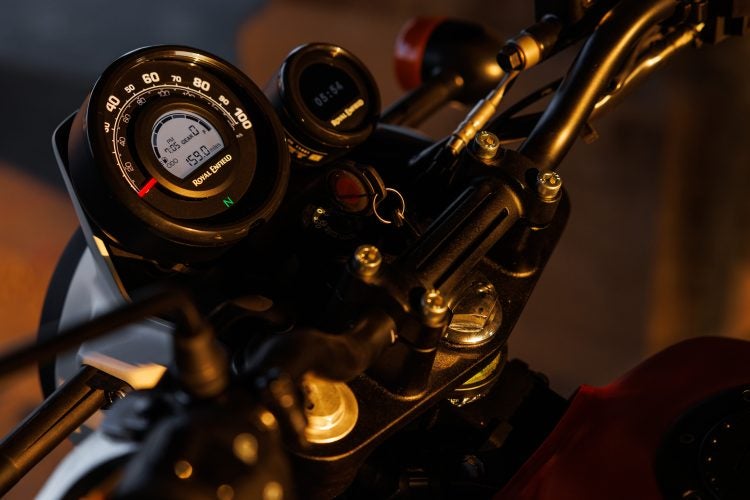
Photo: RENA
We appreciate Royal Enfield’s commitment to affordability, with a $5,099 USD ($6,749 CAD) MSRP. The uncomplicated design means it should be easy and inexpensive to work on, anywhere you might travel. Most Himalayan accessories should be direct bolt-on, meaning there is already plenty of aftermarket support. It is user-friendly, with a tame powerband, low seat height and smooth power delivery. It’s also quirky and unique, which will help it find an audience, because motorcyclists are quirky, too.
The Scram 411 may not seem like much, but considering its target demographic, it is more than enough to stylishly get from any A to B, if you aren’t in a hurry. In the midsize scrambler and dual-sport market, there isn’t much that can compete with the complete style, value and performance package that the Scram 411 provides.
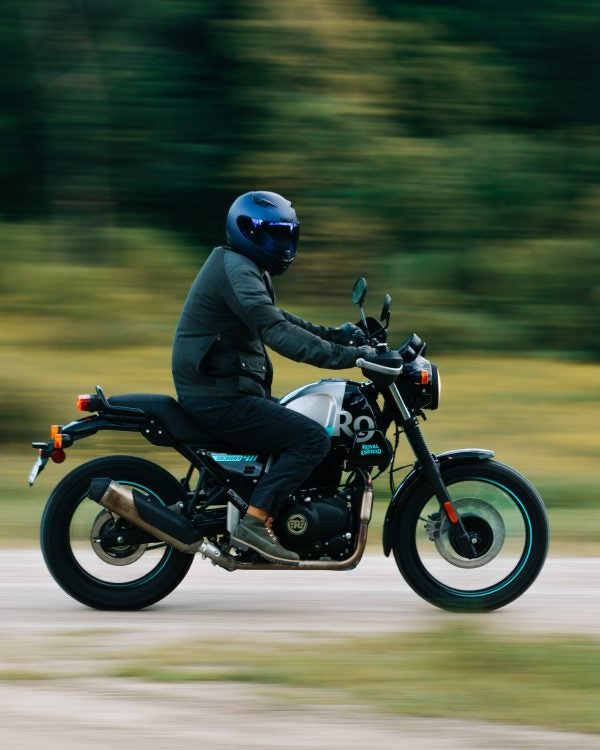
Photo: RENA-Kings Media


